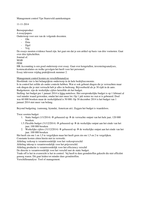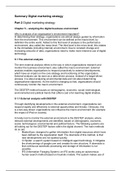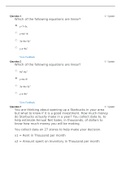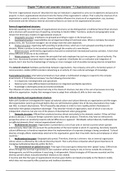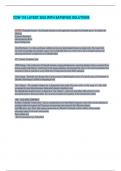Compresence – when our behaviour is influenced by the presence of another
- We behave differently in company then when alone as a result of the social facilitation
effect, whereby the fact that another person is there, changes our behaviour and tends us
to make us more prosocial
- When we meet others, we are onstage, giving a performance that differs from how we
behave offstage
- From social interaction we expect great reward and without interaction we can experience
loneliness, stress, unhappiness and depression (covid-19)
Sociation – the seemingly need for relationships with others → reasons:
1. For optimal well-being, you need to already have a set of social and interpersonal skills,
because our ancestors who lived in groups were more likely to survive, than those who lived
alone → and so the skills involved in developing and maintaining social bonds 2ssumed a
central role in human evolution
2. Through communication you can express your identity → the self (interpersonal being)
emerges through social interaction as a result of our interchanges with others
3. Communication is a pre-requisite for leaning and sharing knowledge within an advanced
human civilisation
4. People with high interpersonal skills cope better with stress, adapt and adjust better, have
greater satisfaction in relationships, have more friends, are less likely to suffer from
depression, loneliness and anxiety, are sensitive to the needs of others, are more liked,
perform better academically, are more likely to receive help and attention, find school
more enjoyable due to friendships, can be effective managers, get paid better
5. Social skills deficit hypothesis – those who lack adequate social skills are more vulnerable to
depression because of their inability to foster positive interpersonal experiences and avoid
negative social experiences
Three core types of psychological need have been identified:
- Competence (wish to feel confident and effective in carrying out actions in order to
achieve goals)
- Relatedness (desire to have close connections and positive relationships with significant
others)
- Autonomy (wanting to feel in control of one’s own destiny, rather than being directed by
others)
Social capital – benefits that come from being socially skilled: fostering a network of committed
relationships characterised by goodwill, trust and reciprocity and developing a good reputation →
research has shown, that there are positive effects of a good patient-doctor relationships with
significant differences in the patient’s well-being
Three levels of research in social skills:
1. Theoretical analyses of how and why people behave as they do
2. Identification and effects of different types of social behaviour
3. Approaches to training in communication skills in order to find out whether it’s possible to
improve social performance of the individual
Communication – the process whereby people share ideas, thoughts and feelings in commonly
comprehensible ways, including two central themes:
1. Intersubjectivity – striving to understand others and being understood in turn
2. Impact – the extent to which a message changes thoughts, feelings or behaviour
, Interpersonal communication is:
1) A process
Communication requires that at least two contributors are involved in an ongoing and dynamic
sequence of events, in which each affects and is affected by the other in a system of reciprocal
determination. Components of the communicative process:
Message the content of communication, whatever is wished to be shared (expression,
thought, feeling)
Code system of meaning shared by a group with signs and symbols (also language)
Noise any disturbance where the communicative act is not in line with its meaning
Feedback the sender is able to monitor the receiver’s reactions and check whether the
message is successfully received – important to positive social outcomes
Context communication takes place within intermeshing frameworks, including:
physical, social, chronological, cultural, geographical (location), time of day
(morning), level of enthusiasm, status, relationship
Communi- people involved in interaction, including interpersonal skills influenced by
cators gender, age, ethnicity, physical appearance and personality
Channel & media richness – concept suggesting that media differ in the wealth of info
medium that they carry (FTF is richer of social cues than text messages)
Channel → the bridge between the sender and receiver (FTF)
- Vocal-auditory channel: carries speech
- Gestural-visual channel: facilitates nonverbal communication
- Chemical-olfactory channel: accommodating smell
- Cutaneous-tactile channel: enables us to make use of touch
Medium → the means of conveying the message
- Presentational: voice, face, body
- Representational: painting, book, architecture, photo
- Technological/mechanical: internet, phone, tv, radio → differences between FTF
and telephone communication:
- To show we aren’t finished with the speech, ‘filled pauses’ as: uhm, er, ah
- Indicators of listening (backchannel behaviour with feedback to the speaker):
uh hu, hmm hm
- Briefer interactions, more formal and task-centred
- More questions are asked during telephone interactions
- Easier to refuse a request
Solution to differences between telephone and FTF: video-mediated communication
(VMC), but also between FTF and VMC are differences:
- With VMC people are not physically together – distanced
- FTF increases the successful sending of info and a good interpretation of messages
- Relation development is more difficult over video, because social presence is
replaced with telepresence (the feelings of being in someone’s presence without
sharing any immediate physical space)
- Perception and understanding of social contexts are weakened
- Sometimes delay in audio signal with affects the interaction flow
- VMC can be more threatening than FTF for those who are already highly anxious
,2) Transactional
Arrow communication goes in one direction only, with interpersonal communication, there is a
system of reciprocal influence from A to B and the other way around.
3) Inevitable
Communication happens, but what if you don’t mean to say something (unintended) with bijv your
clothes? Is that then also communicating? And do you always have to be aware of your intention
(unconscious)? These questions come along with nonverbal communication, which is describes as
informative rather than communicative.
4) Purposeful
Communication is conducted to make something happen (a desired outcome) and also a
strategic enterprise. People communicate their emotions to others for some purpose, whether
intentionally or unintentionally (to get support, negotiate social roles, reinforce social bonds etc).
5) Irreversible
Once info is in the public domain (said), it cannot be re-privatised (taken back). A confidence will
break once a secret is revealed. Solutions: apologies, justifications and excuses (such as torture).
6) Multi-dimensional
There are two levels of communicating process of exchanging messages:
1. Content: issues form the topic of conversation and usually come to mind when thinking
about what we do when communicating
2. Relationships
- Identity projection and confirmation: in the choice of topics, people choose words, forms of
expression, accents, speed of speech, nonverbal behaviours and characteristics to design
a message about themselves in a way that the message has something to do with who the
sender is (self-presentation) and how the sender wishes to be reacted to by receivers
(impression management) → our identity is formulated and evolves as a result of our
interactions, so identity is a reality created in our dealings with others
- Relationship negotiation: relationships are shaped around affiliation (liking), dominance and
intensity of the association (‘shut the fking window’ vs ‘would you mind closing the window,
please’ mean the same, but a different type of relationship is presupposed in each case).
Also social power plays a role → when people with little social power speak to people with
more, they tend to hesitate more, ask more questions, initiate fewer topics of discussion, less
eye contact
, H2 A conceptual model of skilled interpersonal communication
The terms ‘social skills’, ‘interpersonal skills’ and ‘communication skills’ are used as synonyms, the
definition consists of the following separate components:
1) A process
that is characterised by an ongoing verbal and nonverbal exchange of collaborative meaning-
making → the dance of dialogue where individuals align their talk with another
- Formulating appropriate goals with action plans, implementing these plans, monitoring the
effects of behaviour while being aware of the context in which interaction occurs and
finally adjusting, adapting or abandoning goals and responses in the light of outcomes
2) Goals
are behaviours that want to be achieved (desired outcome), and therefore are purposeful
(sometimes unintentionally/unconsciously). The human being is an intentional system, designed
to pursue goals, which motivates and navigates the interpersonal process. People often
consciously decide the point they want to make in an argument without being conscious about
how they construct the statements they use to convey this point. We move through four stages
while learning new skills:
1. Unconscious incompetence where we are unaware of the fact that we are behaving in a
incompetent manner → Dunning-Kruger effect = people overestimate their true ability and
ignore their actual lack of skill
2. Conscious incompetence – we know what we should be doing, but we also know we are
now doing it well
3. Conscious competence – we are aware that we are performing at a satisfactory level
4. Unconscious competence – we perform the actions without thinking about them and we
succeed
3) Learning
Most forms of communication displayed in social contexts are learned, not just intuitive (like
walking). An important step in social development is treating infants as a communicative being.
Communication is central to the development of cognitive abilities. Studies showed:
- Children from culturally richer home environments tend to develop more appropriate social
behaviours than those from socially deprived backgrounds, where the key factor is parental
responsiveness to the child’s early communication → parents with a high socioeconomic
background use more different words
- Children seem to imitate and model their same-sex parent’s way of acting, while talking
with the same accent of the peers of the kid, despite the accent of the parent(s)
- A child learns the behaviours that are encouraged most (reinforcement)
4) Cognitive control
A skilled person doesn’t only know how to do certain things, but also understands why. A socially
disadvantaged person may have learned the basic elements, but not the thought processes
necessary to control the utilisation of these elements. Zimmerman (2000) identified four key
stages in the learning of skills:
1. Observation – a person watches others perform, paying attentions to other dimensions such
as motivational orientation, values and performance standards
2. Emulation – the individual is able to execute a behavioural display to get in line with that
what is observed → responses are emulated, not replicated
3. Self-control – when an actor begins to master a skill
4. Self-regulation – when a person learned to use the skill across different personal and
contextual conditions
6) Interrelated
Each behaviour relates to a common goal, and so the behaviours are synchronised


